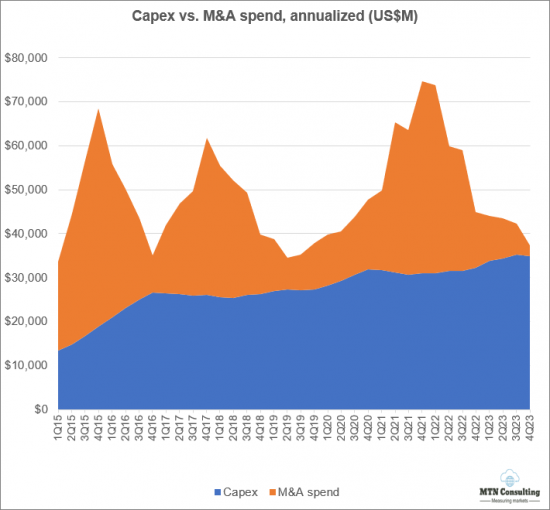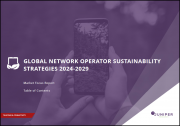
|
시장보고서
상품코드
1481476
캐리어 뉴트럴 네트워크 오퍼레이터(CNNO) : 시장 리뷰(2023년 4분기) : 2023년은 매출 5% 증가, 설비 투자 8% 증가, M&A는 유기적 성장에 따라 감속, PE 기업은 업계 재편을 계속, 생성 AI 과대광고 증가Carrier-Neutral Network Operators - 4Q23 Market Review: Revenues up 5%, Capex up 8%, in 2023, M&A Slows to Trickle as Organic Growth Takes Over, PE Firms Continue to Reshape Sector and GenAI Hype Builds |
||||||
캐리어 뉴트럴 네트워크 오퍼레이터(CNNO) 시장의 성장과 발전을 리뷰하고, 세계 47사의 CNNO에 대해 2011년 1분기부터 2023년 4분기까지의 폭넓은 재무 통계를 추적 조사하고 있습니다.
2023년 연간 대상 기업의 매출은 997억 달러(전년대비 5.1% 증가), 설비 투자는 348억 달러(전년대비 7.8% 증가)였습니다. 2023년말 시점에 이 CNNO는 2,611억 달러의 순PP&E(전년대비 3.9% 증가)를 보유하며, 약 11만 3,000명(전년대비 2.1% 증가)을 고용하고 있습니다.
비주얼

리포트 하이라이트 :
- 매출: 2011년 200억 달러 이하였던 CNNO 부문의 매출은 2023년 997억 달러에 달할 것입니다. 이 5.1%의 성장은 지난해 웹 스케일 부문의 6.2% 성장보다 약간 느리고, 2023년 통신 사업자가 경험한 1%의 매출 감소를 훨씬 상회하는 것으로, 2023년 매출 상위 5개 CNNO는 China Tower(CTC), American Tower(ATC), CTC는 셀타워, Equinix는 데이터센터, Level 3는 파이버/대역폭, ATC는 셀타워, ATC는 데이터센터, Level 3는 파이버/대역폭입니다. 그러나 ATC는 셀 타워, 데이터센터, 파이버에 걸쳐 있고, Crown Castle은 셀 타워와 파이버를 모두 보유하고 있습니다. 두 회사 모두 CNNO 부문의 인프라 수렴 추세를 잘 보여주고 있으며, 개별 기업은 보다 완전한 '플랫폼' 자산을 소유함으로써 시너지를 추구하고 있습니다.
- 시장은 10년 동안 5배 이상 성장했고, 그 전망은 극적으로 확대되었습니다. 가장 중요한 것은 통신 사업자들이 자산을 분사하여 많은 CNNO를 설립하거나 확장했다는 점입니다. 예를 들어 차이나타워는 2015년 중국 정부가 중국 국영 통신사 3곳의 타워 보유 자산을 통합하면서 시장에 진입했습니다. 규모는 훨씬 작지만, 미국에 본사를 둔 유니티 그룹(Uniti Group)은 2015년 통신사 윈드스트림(Windstream)이 패시브 네트워크 인프라의 대부분을 분사하여 설립한 회사로, 지난 10년간 CNNO 부문을 성장시키기 위해 이러한 분사가 많이 이루어졌습니다. 2011년 이후 M&A 총액은 2,280억 달러로, 같은 기간 설비투자액인 2,910억 달러에 크게 못 미치는 수준입니다.
- 설비 투자: 2011년 60억 달러였던 CNNO의 설비 투자는 2023년 348억 달러에 달합니다. 이는 통신사업자와 웹스케일러의 설비투자가 각각 4%와 5% 감소한 2022년 대비 8% 가까이 증가한 것으로, CTC의 설비투자액이 가장 높고, Digital Realty, Equinix, Cellnex, NBN Australia가 그 뒤를 잇고 있습니다.
- 수익성: CNNO 부문의 2023년 평균 순이익률은 2.9%로 2022년 -0.2%에서 상승했지만 2021년 6.8%에서 하락했습니다. 잉여현금흐름 마진도 4.9%로 2021년 10.4%, 2022년 11.5%에 비해 절반 이하로 떨어졌습니다. 2023년 기준 CNNO의 대차 대조표에는 2,430억 달러에 가까운 부채가 있었고, 현금과 투자액은 1,900억 달러가 조금 넘었습니다. 수요 호조에도 불구하고, 일부 CNNO는 막대한 부채로 인해 경영을 합리화하기 위해 노력하고 있습니다.
- 직원CNNO의 2023년 직원 수는 약 113,000명이며, CNNO는 인프라를 효율적으로 운영하고 인건비를 낮추기 위해 가능한 한 자동화를 추진하고 있습니다. 그러나 대부분의 CNNO는 M&A를 진행하기 때문에 규모와 시너지 효과를 누리기 전에 자산을 통합하고 합리화해야 하는 경우가 많습니다. 인력 조정이 이루어지기 때문에 약간의 지연이 발생하기도 합니다. 직원 1인당 매출으로 보면 CNNO 부문은 2023년 89만 달러를 넘어 2022년 87만 달러에서 소폭 증가할 것으로 예상되며, 2023년 웹스케일의 58만 4,000달러, 통신사의 39만 2,000달러와 비교하면 그 차이는 분명합니다.
대상 범위
이 리뷰에는 다음 기업이 포함되어 있습니다. :
|
|
목차
- 1.리포트 하이라이트
- 2.CNNO 부문의 개요
- 3.분석
- 4.운영 지표
- 5.주요 통계
- 6.부문별 드릴다운 분석
- 7.기업별 드릴다운 분석
- 8.기업 벤치마킹
- 9.미가공 데이터
- 10.환율
- 11.MTN Consulting, LLC 소개
This report reviews the growth and development of the carrier-neutral network operator (CNNO) market. The report tracks a wide range of financial stats for 47 CNNOs across the globe, from 1Q11 through 4Q23. For the full-year 2023, the companies covered by this study represented $99.7 billion (B) in revenues (+5.1% YoY), and $34.8 B in capex (+7.8% YoY). At the end of 2023 (EOY23), these CNNOs had $261.1B of net plant, property and equipment (net PP&E) on the books (+3.9% YoY), and employed approximately 113,000 people (+2.1% YoY).
VISUALS

The CNNO market is the smallest of three operator segments tracked by MTN Consulting on a quarterly basis, alongside telco & webscale, but CNNOs play a crucial, complementary role in the communications sector and own and operate a large portion of the world's cell towers, data centers, and fiber networks. In the old days, telcos did it all: they owned all the network infrastructure, they manufactured the switches and transmission gear deployed in the network, and even provided CPE. That model is long since extinct. The telco of 2024 cobbles together its physical network from a mix of owned and leased or rented resources. Cloud providers in the webscale world do the same; while they spend heavily on capex ($192B last year), they generally lease fiber or transmission bandwidth, and only own a portion of their data centers. CNNOs do serve other end markets, including various enterprise verticals (finance, media, and energy), and government. But telcos and webscalers are the biggest targets. CNNOs play a vital role in the network design and cost structure of these operators.
In addition to demand from the telco & webscale markets, other factors driving the development of the CNNO sector over the last decade include: low interest rates (in the past) enabling debt-financed expansion (M&A and capex); the tax advantages of the real estate investment trust (REIT) operating model; and, the growth of the asset pool managed by private equity, a key source of funding for CNNOs. Private equity is the single largest force driving the CNNO market today. Recent developments include: Blackrock acquired Global Infra Partners (1/24); Blackstone partnered with Digital Realty on a $7B hyperscale JV (12/23); Brookfield bought Cyxtera (11/23) and the Indian tower assets of American Tower (1/24); EQT acquired EdgeConneX (1/24); KKR purchased TIM's fiber network NetCo for $24B (1/24). More broadly, a number of large PE firms are creating portofolios of "digital infrastructure" assets, and buying up or funding new CNNOs. They're attempting to create synergies across their digital investees, sometimes through mergers, and synergies with other parts of their investment portfolio. With the rise of GenAI, for instance, some PE firms are investing directly in energy supply in order to ensure competitive rates and terms for the data center players in their portoflio.
Below are some highlights from the report:
- Revenues: from under $20B in 2011, the CNNO sector recorded revenues of $99.7B in 2023. This 5.1% growth is only a bit slower than the 6.2% growth of the webscale sector last year, and far ahead of the 1% revenue decline experienced by telcos in 2023. The largest 5 CNNOs by revenues in 2023 were China Tower (CTC), American Tower (ATC), Equinix, Level 3, and Crown Castle. Three of these are almost entirely focused on one type of infrastructure: cell towers for CTC, data centers for Equinix, and fiber/bandwidth for Level 3. However, ATC has substantial holdings across cell towers, data centers, and fiber, while Crown Castle has both cell towers and fiber. Both are good representations of the trend towards infrastructure convergence in the CNNO sector, where individual corporate entities seek out synergies from owning a more complete "platform" of assets. Many private equity firms are also attempting to create a virtual "platform" through holdings across different portfolio companies, but it's not clear that this can be truly accomplished without a single corporate entity, ideally with public reporting requirements.
- To grow over five-fold in a decade, the scope of the market has expanded dramatically: most importantly, telcos have spun off assets to create or enlarge many CNNOs. For instance China Tower entered the market in 2015 when the Chinese government merged the tower holdings of that country's three state-owned telcos. On a far smaller scale, US-based Uniti Group was created in 2015 when Windstream, a telco, spun out most of its passive network infrastructure holdings. Many other such spinoffs were accomplished over the last decade in order to grow the CNNO sector. This is why the CNNO sector spends so heavily on M&A: since 2011, M&A spending has totaled $228B, not much less than the $291B capex spend for the same period.
- Capex: from ~$6B in 2011, CNNO capex was $34.8B in 2023. That is up nearly 8% from the 2022 total, in a year when capex for telcos and webscalers fell 4% and 5%, respectively. CTC reported the highest capex, followed by Digital Realty, Equinix, Cellnex, and NBN Australia. A major reason for CNNO's healthy capex last year was widespread enthusiasm for generative AI, and an investor view that CNNO data centers can ride this enthusiasm to faster growth as long as they invest now, in a big way. To speed development, the two largest data center-focused CNNOs are both using creative financing vehicles to build hyperscale-class facilities for the big cloud providers. In December 2023, for instance, Digital Realty announced a $7B JV with Blackstone, to build 4 hyperscale campuses across three metro areas on two continents, supporting an IT load of up to 500MW, or the equivalent power needs of over 300K households.
- Profitability: average net margin for the CNNO sector was 2.9% in 2023, up from -0.2% in 2022 but down from the +6.8% of 2021. Free cash flow margin also disappointed in 2023, amounting to 4.9%, less than half of the 10.4% and 11.5% recorded in 2021-22 respectively. Rising interest rates were one of several factors. CNNOs had nearly $243B of debt on the balance sheets at EOY23, and just over $19B in cash & investments. Even with strong demand trends, some CNNOs are attempting to streamline operations in order to cope with their heavy debt load. American Tower, for instance, sold off its Indian operations for $2.5B in Jan. 2024, to Brookfield.
- Employees: CNNOs ended 2023 with about 113K employees, from 110.7K at EOY2022. CNNOs aim for efficiency in the operation of their infrastructure, and use automation when possible to lower labor costs. However, most CNNOs engage in M&A and hence often need to integrate & rationalize assets before they can reap the scale & synergy benefits. There can be some delay as adjustments to the workforce are made. On a revenue per employee basis, the CNNO sector is impressive, at over $890K per employee in 2023, up slightly from $870K in 2022. This compares to $584K for webscale in 2023, and just $392K for the telco market.
COVERAGE:
The following companies are included in this Market Review:
|
|
Table of Contents
- 1. Report Highlights
- 2. CNNO Segment Overview
- 3. Analysis
- 4. Operating Metrics
- 5. Key Stats
- 6. Segment Drilldown
- 7. Company Drilldown
- 8. Company Benchmarking
- 9. Raw Data
- 10. Exchange Rates
- 11. About



















